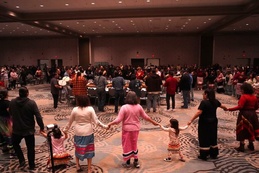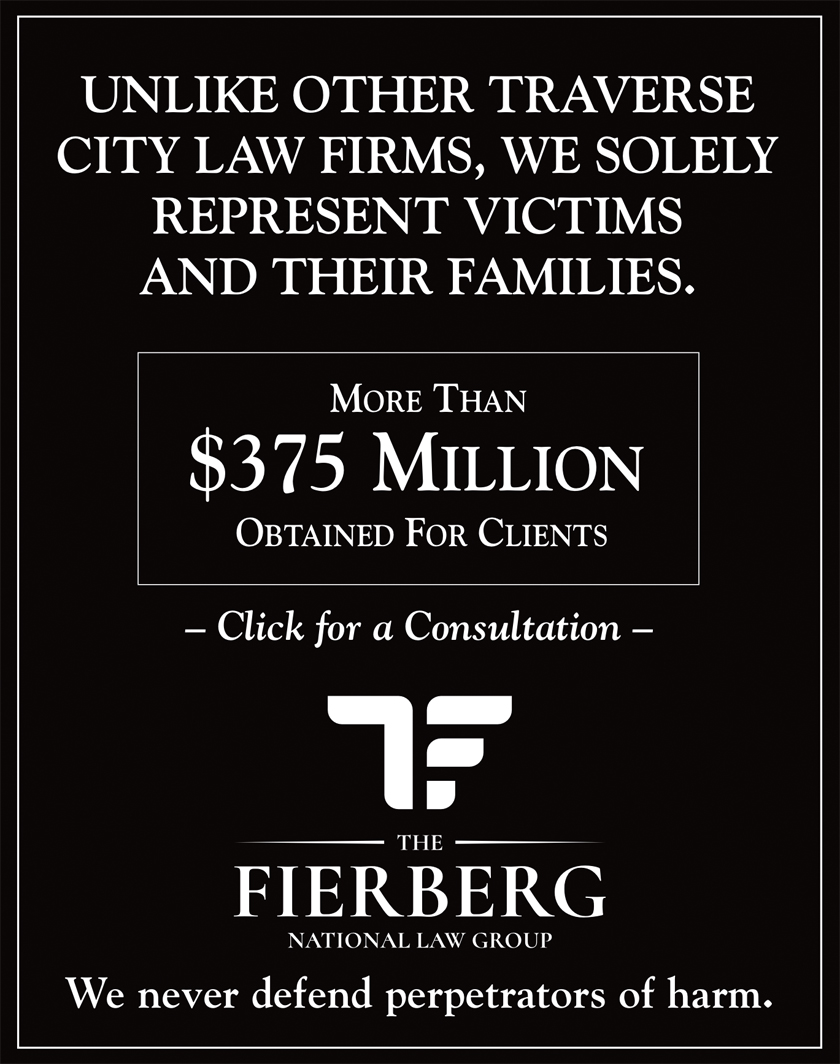
Traverse City’s Safe Harbor
One year in: Lessons learned, successes seen.
By Patrick Sullivan | May 5, 2018
The longtime NIMBY debate about creating a permanent homeless shelter on Traverse City’s Wellington Street — near the public library, a neighborhood, and main thoroughfare — came to a decisive close when Safe Harbor finally opened its doors in 2017. While it hasn't been the nightmare many predicted, it experienced some serious issues even its supporters and board members didn’t anticipate. Northern Express takes a look at the shelter’s first year, the lessons learned, and successes it spurred.
Safe Harbor faced some unexpected challenges in its first year at its new permanent location, including numbers that were way up, a nearby gas station that suddenly got a license to sell booze, and a small population who apparently wanted to use the shelter as a means to party.
Nonetheless, Safe Harbor officials called the inaugural year a success, albeit one in which they learned a lot.
“I think, overall I’m going to say it was a huge success,” said Mike McDonald, chairman of the Safe Harbor board of directors. “With any operation like this, when you’re opening a shelter for the first time, we certainly found a list this long of things we want to address this summer.”
SURPRISED BY THE NUMBERS
Perhaps the biggest surprise was the number of people who showed up. That took McDonald and fellow board member Christie Minervini by surprise.
“Due to area economic conditions, lack of housing for people that are mentally ill — and partly due to the opioid crisis — we had a fairly significant increase in guests that we did not totally anticipate,” McDonald said. “We thought we would probably have more, having a central location like this, but the increase surprised us.”
Safe Harbor served 268 individuals between early November and April. An average of 57 guests stayed each night, for a total of 8,368 bed nights, a 40 percent increase over the numbers Safe Harbor served, via a rotating roster of churches who hosted those in need of shelter, the year before. On the upside, many guests found housing, either on their own or through service providers, making the average length of stay just 31 days.
Despite the flow of people off of the street, though, on its busiest nights, Safe Harbor neared capacity, with 73 or 74 guests. McDonald said the shelter had 72 beds and plans to increase that to 82 next season. Their special land use permit allows them to house up to 90 guests.
Minervini said she initially thought Safe Harbor was attracting guests away from the Goodwill Inn.
“For the first maybe month or so I would periodically check in just to see, ‘Are your numbers down? Because ours are up. Are we getting your people?’ And they’re like, ‘Oh no. We’re to capacity,’” she said. “So I think it’s just an across-the-board increase in people experiencing homelessness.”
Minervini partly blames stalled construction of affordable housing. It’s been two years since “voucher qualified” housing has been built in the region.
“One thing I learned really early on is the number of people on the street is not finite, and they’re not the same people,” she said. “There are people constantly going in and out of homelessness. Many of them find a way out of it themselves; some of them need assistance.”
Dan Buron, executive director of Goodwill Northern Michigan, which runs the Goodwill Inn, said that from a distance, he was impressed with the way in which Safe Harbor’s first season in its new home went off, despite the challenges.
“I was impressed,” he said. “I think it went really well.”
Buron said the uptick in homeless numbers is troubling. Also troubling, he said, is that the average age appears to be getting younger.
“Certainly, we know that housing is a challenge, but it’s been a challenge, so that’s not new,” Buron said. “[The number of younger people seeking shelter] was concerning. I thought maybe this was some kind of blip, but it stayed, and I was very surprised. … It’s just hard to say exactly what that means.”
MARATHON CHALLENGE
Something new appeared in the neighborhood in the months leading up to Safe Harbor’s opening on Wellington Street that took Minervini and the rest of the Safe Harbor board completely by surprise — the Marathon gas station less than a block away on Eighth Street got a license to sell beer and wine.
“It was surprising and, of course, many of our guests will stop there in the morning or in the late afternoon,” Minervini said.
The station is owned by Schmuckal Oil Company of Traverse City and sells items that are popular with the Safe Harbor clientele.
On a recent day, a couple of rough looking Safe Harbor residents emerged from the store with armfuls of 25-ounce cans of Natty Daddys, a high-alcohol, low-cost beer. In front of the register, the station sells of BuzzBallz Chillers, a 17-percent alcohol compact drink that sells for $2.99.
David Waldron, Schmuckal Oil’s chief operating officer, said he had no comment.
Residents of the neighborhood north of Eighth Street find those “BuzzBallz” bottles discarded in their yards and in the alleys, said Elizabeth Whelan, president of the Boardman Neighborhood Association. Whelan said it appears to her as though Marathon is catering to the homeless population.
She said Safe Harbor is not responsible, obviously, for what happens at Marathon, but it is an unfortunate circumstance. She said each morning when the shelter doors open, guests stream out, cross Eighth Street at Wellington, where there is no crosswalk, and line up to buy alcohol.
“It’s a mad rush to the gas station,” Whelan said. “Safe Harbor didn’t anticipate this.”
Whelan straddles two sides of the Safe Harbor debate — she’s long worked for the Father Fred Foundation and believes in helping people who are living in poverty. She also frequently hears complaints from people in the neighborhood, especially people who live near Wellington Street, about shelter guests.
“I’m very grateful that Safe Harbor is there, but there have been many issues, more issues, I guess, than I anticipated,” she said. “Thank goodness it was open. I mean, it was a horrible winter and people would have potentially died this year. But we need our neighborhood respected. I don’t think that’s asking too much.”
Problems have included: public urination, vomiting on lawns, people loitering in alleys, people passed out in alleys, and yards littered with bottles and hypodermic needles.
“I witnessed one myself — an individual rolling around in the lawn across the street, couldn’t get up,” Whelan said. “This was at 10 o’clock in the morning.”
Whelan said she appreciates Safe Harbor’s willingness to hear complaints and the responsiveness of Traverse City Police.
Whelan said she doesn’t know what the solution is, but she hopes that Safe Harbor and its partners can figure out how to reduce bad behavior that flows from the shelter.
“I don’t want to seem like I’m down on the homeless, because I work with the homeless, and I’m not,” Whelan said. “I don’t feel like they are respecting our neighborhood, some of them.”
McDonald noted that the Boardman Neighborhood experienced similar problems before Safe Harbor opened because the neighborhood is located in the center of a corridor traveled by people looking for homeless services.
“You know, these folks didn’t just suddenly appear here because of the shelter,” McDonald said.
SHELTERING FRAT PARTIES?
George Golubovskis is an advocate for people experiencing homelessness in broad sense (he served on a planning commission subcommittee that considered how Safe Harbor’s special use permit application) and in personal sense (he’s homeless and in late April, he lobbied for Safe Harbor to extend its season while below-freezing temperatures were forecast.)
“There’s that Bible verse people bring up — ‘What you do for the least among us, you do for me,’” he said. “I don’t think there’s an asterisk at the end that says, ‘Well, not after mid-April.’”
While he is an ardent shelter supporter, Golubovski said he believes that the permanent shelter has attracted more people from out-of-town.
“I would say, proportionally speaking, most people are from Grand Traverse County, or the five-county region, but there were a lot of people from downstate. You know, it was a, ‘build it, and they will come’” situation, he said. “I know that’s used by opponents of Safe Harbor.”
Golubovksi, though, is worried about what an influx of younger out-of-towners could mean for the viability of Safe Harbor in the future, because many of the newcomers are disrespectful or even rude to volunteers, and Safe Harbor has a hard enough time finding people to donate their time.
“If anything, I probably speak more for the volunteers that want to speak up, even more so than other fellow people that are experiencing homelessness,” he said. “I’m always going to acknowledge volunteers. They were amazing.”
There were people who stayed at Safe Harbor this season who, from Golubovski’s perspective, didn’t need to be there.
“It became a fraternity party for some people. I think it skews a little bit younger,” he said. “I’m just like, ‘What are you doing here?’ When I was their age, I was working. I do think there were people that were taking advantage of the system.”
Minervini and McDonald rejected the notion that people have been drawn to Traverse City because of the permanent shelter.
“Something like 85 percent of our guests are from Grand Traverse County. And another five or six percent are from the five-county area. I think less than five percent are from outside northwest Michigan,” McDonald said. “Do we occasionally have somebody show up from Chicago or wherever? Yes, we do, but not very often,” McDonald said.
Minervini said other factors draw people to northern Michigan before they become homeless.
“They’re not coming here to stay at Safe Harbor,” she said. “They are coming here because they were promised a job that didn’t pan out, or because of an invitation from a family member that didn’t pan out, or whatever.”
Minervini, though, said shelter operators learned this season that guests should be screened to make sure they should be there.
“We haven’t actively practiced diversion techniques,” she said. “If you come to stay with us, we don’t ask you qualifying questions like, ‘Can you prove you’re homeless?’ or ‘Why are you staying with us tonight?’ There are things that we can do, things that we can say, and assistance that we can give when someone comes to stay with us the first time, to kind of divert them back to another safe place to be.”
Minervini said “some, not many” people used Safe Harbor like a drop-in center, a place to get a meal, a shower, and to do laundry before heading back out onto the street for the night, presumably because guests in the building are prohibited from using drugs or alcohol.
“I look at those folks as, ‘Well, where are you going? Where are you staying?’” she said. “We really want to be sure that we are providing emergency shelter to those who truly need it.”
MINISTRY THAT’S NOT FOR EVERYONE
Glenda Andrews knows a thing or two about providing services to the homeless. She helped start Grace Episcopal Church’s Jubilee House on Washington Street a dozen years ago, and she understands the growing pains experienced at Safe Harbor.
“It’s been a rough year [at Safe Harbor], and the steering committee knows that,” said Andrews, Jubilee’s director. “I’m trying to be very optimistic and positive about it. … I think this year is a year of adjustment. I think next year will be a lot smoother.”
Andrews said an organization like Safe Harbor needs to mature and figure things out. The first couple years at Jubilee were rough, too, she said, until volunteers learned how to set and enforce the right set of rules.
“This is not a ministry that anybody can do. It really is not,” she said.
Andrews believes that Safe Harbor needs to have paid overnight staff (something that Minervini said is in the works for next season). Safe Harbor, Jubilee, and Central United Methodist Church (which hosts weekday breakfasts) all aim to serve the people in need, but Safe Harbor faces the biggest challenges. Andrews said many guests spend the afternoon drinking, and are often intoxicated when they arrive at Safe Harbor; during the night, some of those guests begin to detox.
Rotating bands of volunteers, no matter how well meaning, are not equipped to deal with that, she said.
“I think they are demanding a little too much of the volunteers,” Andrews said. “I’m hearing they are tired; they are very tired after a long winter.”
Also, moving from being a church-based shelter to a permanent building has created new challenges, she said, because churches are sacred spaces. Jubilee House is on a church campus, and inside it feels like a small home, which instills a sense in visitors that they need to treat the place well; Safe Harbor’s permanent home is institutional, sterile, and almost jail-like. That affects the way guests behave, Andrews said.
“In church, there’s reverence. In a church, even if you’re not religious or spiritual, there’s still reverence there that demands respect,” Andrews said. “I don’t know what you can do to soften a building.”
Minervini disagreed that volunteers suffered from fatigue this year, even though the season was the longest ever for Safe Harbor because of winter weather that persisted well into spring.
“We received notification from one very small church that has an aging congregation that they would not be coming back with us this coming fall,” Minervini said. “But I believe we picked up two new ones this year.”
Minervini said overnight volunteers faced challenges, but they worked through them.
“We did have an issue early on in the season where the police department were bringing folks in after our 11 o’clock hard timeline,” she said. “There’s a new arrival that they may have found in a snowbank someplace, and, ‘Can we take them?’ Well, we did have volunteers who were expressing concerns. They just didn’t feel comfortable or confident in bringing in someone that they didn’t know.”
Safe Harbor worked with police, who agreed to take people to the Goodwill Inn overnight, which is professionally staffed.
POLICE CALLS AND SOLUTIONS
Traverse City Police were called to Safe Harbor 84 times between Nov. 1 and April 22, according to the department’s incident records.
That includes non-emergency calls, like when officers visit to give a presentation, and it also includes false alarms, said Capt. Jim Bussell. The number does not, however, capture all of the activity that required police response to folks heading to or from the shelter, such as the Marathon station, Family Video, or the Webster Street alley, where officers were also sent.
The Safe Harbor calls include 15 ambulance calls, three suicide attempts, and one mental health call. The largest category was disorderly conduct calls, which numbered 24. Calls that could have resulted in criminal investigations included six assault reports, three larcenies, and five for trespassing.
Traverse City police Capt. Keith Gillis said despite some bumps, he considered Safe Harbor’s inaugural year a success, and he expects things to improve next year. He said it helps police to have the shelter located in one place.
Everyone — including the homeless population — learned this year, he said, adding that some simply needed to be reminded where they should not hang out and drink.
On the last weekend that the shelter was open, one guest stabbed another guest during a fight near the railroad tracks just outside the shelter. Minervini said that wasn’t representative of how things went this year.
“The vast majority of calls that we get here are health-related rather than any sort of violence,” Minervini said.
McDonald agreed.
“The stabbing the other night was unusual, and it would have been unusual any given year. But we’ve had incidents where we’ve had guests fighting with each other and things like that in the churches,” McDonald said. “It maybe wasn’t as visible.”
Safe Harbor guests were also the source of many police calls to the Traverse City Area District Library, though library administrators succeeded in drastically reducing incidents over the season.
The library saw an increase in incidents and patron suspensions due to drunkenness and drug use after Safe Harbor opened for the season.
“I guess I was surprised at the number of problems that we had; I didn’t expect that much of an increase,” said Gail Parsons, library director. “At first our staff really took the brunt of the problem. You know, we have a list of rules and regulations that everyone has to abide by, and it doesn’t matter to us were you come from, you know, you have to comply.”
While she said she could not be certain that troublemakers were Safe Harbor guests, there was plenty of circumstantial evidence pointing in that direction.
From November, when the shelter opened for the season, until February, problems at the library increased roughly 400 percent from over the same period the prior year, Parsons said. In February, Parsons and library sight and sound coordinator Aaron Olson made a presentation at Safe Harbor.
“We both spoke, letting them know that, yes, this is a public place, and everyone is welcome to come into the library — unless you misbehave,” Parsons said.
They hung posters that listed library rules and several residents approached them afterward, apologizing on behalf of others.
Parsons said that following that presentation, incidents of disruption at the library almost stopped.
“Once we did that, it was amazing how quickly things turned around,” she said.
Minervini said that working through the problems is important because Safe Harbor’s mission is so crucial.
“I do in my heart know that we’re making a difference, and that there are people who are alive now and there are people who are housed now because of having come into Safe Harbor,” she said.
Trending

Our Top Stories of 2025
Each year, we look back at the stories we’ve shared over the last 12 months and pull together the ones that got the mo… Read More >>
A Solo Rattler
Frontman of folk-rock band Michigan Rattlers Graham Young brings his solo performance to Great Lakes Center for the Arts in … Read More >>
GTB Starting the Year with Tradition
The Grand Traverse Band of Ottawa and Chippewa Indians hosts the Kchi Wiikwedong Anishinaabek Maawnjidowin Round Dance on Ja… Read More >>


